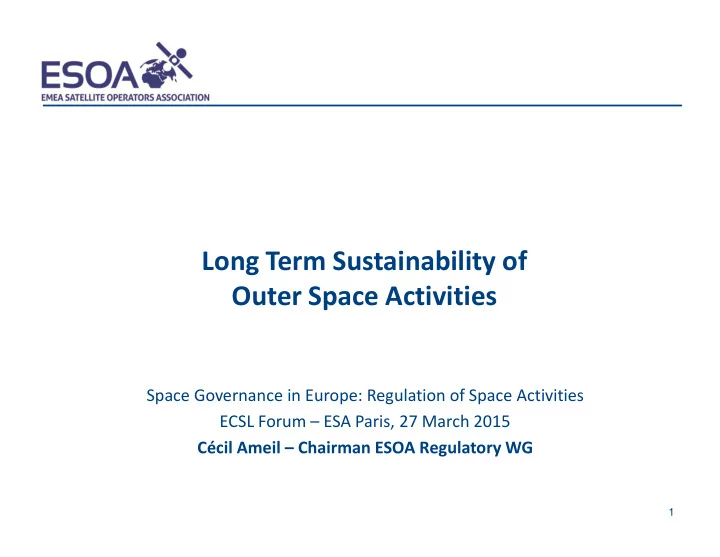

Long Term Sustainability of Outer Space Activities Space Governance in Europe: Regulation of Space Activities ECSL Forum – ESA Paris, 27 March 2015 Cécil Ameil – Chairman ESOA Regulatory WG 1
ESOA Members CIS Space Systems 2
Presentation Outline Key Facts on the Commercial Satellite Industry 1. Satellite Industry’s Commitment to Sustainable 2. Space Operations A Need for Responsible International / Regional 3. Regulations 3
KEY FACTS 4
More than 50 countries on 6 continents, more than 50 years of on-orbit experience 5
Commercial Satellite Operations 6
Satcoms anywhere, anytime 7
SUSTAINABLE OPERATIONS 8
Views on Space Sustainability M AINTAINING A SUSTAINABLE SPACE ENVIRONMENT IMPLIES : Responsible behavior by those launching/ operating space objects Responsible regulation of space-related activities in particular spectrum management/ allocation of orbital slots & associated frequencies � A safe & enabling environment for satellite operation that avoids unnecessary regulatory burdens This requires a dialogue between all stakeholders & pragmatic solutions that do not impact operations S ATELLITE OPERATORS CONTRIBUTE TO THIS DIALOGUE WITH : Decades of experience in safe space operations In depth knowledge of international, regional & national regulations that they comply with 9
Responsible Behavior: What satellite operators do? S ATELLITE OPERATORS HAVE A VESTED INTEREST IN ENSURING SAFE OPERATIONS AS DISRUPTIONS DAMAGE CUSTOMER RELATIONSHIPS , HARM USERS , & COST MONEY ! I NDUSTRY BEST PRACTICES ARE STATE OF THE ART & EVOLVE CONSTANTLY Some Satellite operators carry Space Situational Awareness sensors on their satellites to monitor & react to the space environment to avoid collisions & interference New standards are emerging to ensure secure uplinks from identified sources (carrier ID) or deal with interference (prevention & resolution) Ongoing collaboration within the space industry: E.g. Space Data Association, Global VSAT Forum, Satellite IRG 10
Dealing with Interference 11
Dealing with Interference T YPICAL OPERATIONAL INTERFERENCE CAUSES INCLUDE : Poor equipment Poor installation (wrong satellite, polarization, frequency….) Carrier ID / Installers training / Centrally controlled equipment (MSS) O THERS CASES INCLUDE : Transmission in geographical or bands vicinity (e.g. ROES in C Band) � Protect satcoms unfettered access to spectrum! J AMMING : Intentional interference – very limited Political issue / ITU diplomacy 12
The Space Data Association A T OOL FOR C OLLABORATIVE SSA & S AFE S PACE O PERATIONS S PACE D ATA C ENTER (I T ’ S ALL ABOUT SHARING DATA !) Distributed, secure environment providing assured availability Secure, legally protected sharing of proprietary data Authoritative, verified, normalized, current data Automated validation of data and analysis/reporting S IGNIFICANTLY IMPROVES AND ADDS TO HERITAGE PROCESSES Efficient, timely, accurate conjunction assessments Consolidated use of best available operator data including planned maneuvers Significantly reduces false alarms, missed events: increases safety & efficiency Addresses format inconsistencies & inherent errors Supports improved EMI / RFI geo-location & resolution support SDA community facilitates evolution & adoption of best practices by satellite operators ⇒ SDA Enhances Satellite Operations & Lowers Operational Costs ⇒ Aiming at improving Integrity, Safety & Resilience ⇒ 13
SDA Participating Operators Participation in 2013: 19 satellite operators, 333 satellites 14
RESPONSIBLE REGULATIONS 15
Responsible Regulation: The International Dimension S ATELLITES ARE NECESSARILY AN INTERNATIONAL BUSINESS Whether GEO or MEO, satellite systems cover a large part of the earth’s surface Some operators operate global fleets (up to 55 satellites) Actors from multiple States own & operate satellites GLOBAL REACH IS A SATELLITE CORE STRENGTH T HE ITU PLAYS A FUNDAMENTAL ROLE It allocates orbital slots & associated frequencies to satellite & terrestrial systems and so aims to prevent interference between them It reviews & updates all rules related to access to & use of radio spectrum & the GEO orbit at the WRC (World Radio Conference) every 3-4 years, and is the accepted means of achieving international consensus in these matters T HE I MPORTANCE OF THE WTO & I NTERNATIONAL T RADE C ONDITIONS The satellite industry relies on “Open Skies” & equally open trade relations between states, so their inherently international services can benefit the maximum number of users 16
Responsible Regulation: Stability & Predictability O UR INDUSTRY ’ S CHARACTERISTICS : Long-term - often private - investments Long life cycle: 15-20 years Long-term risk profile: business plans based on entire lifecycle Long-term contracts for essential services (global information via broadcasting/ emergency communications/ maritime safety/ GSM backhaul/ rural connectivity/ security & defense) � The EU satellite industry has flourished at all levels within the existing regulatory environment….. � But the satellite industry still needs unfettered access to spectrum! 17
EU Harmonisation in Space Law? � Currently there is no overarching EU framework for use of Outer Space � Internationally there are different practices � EU space industry has developed successfully within these divergent national structures � EU Art. 189.2 does not extend competencies to harmonise Space Legislation – Horizontal competencies on internal market or competition are available � What issues can be improved? Impact of “Forum Shopping”? � Effect of EU legal harmonisation vs. soft harmonisation 18
Protect satellite spectrum Regional bodies, incl. the CEPT and the EU, work on spectrum policy � liberalisation (increasing flexibility) Clearly there is a strong demand for terrestrial mobile broadband � communications However, it is important that policy makers balance that demand with the � need for countries and citizens to have access to other means of communications as well, such as critical satellite services using C, Ku and Ka band frequencies Many other frequency bands are available for IMT, and more desirable from a � coverage perspective or for very high data rate demand (5G) We encourage all countries and companies to actively participate to the ITU � preparatory work for the next WRC-15 in order to preserve satellite C Band and ensure that future 5G systems operate in unused spectrum (> 31 GHz) We encourage all ITU regions to adopt Common Positions that make it clear � that satellite services are essential worldwide and cannot be compromised with an opening to IMT 19
Recommend
More recommend